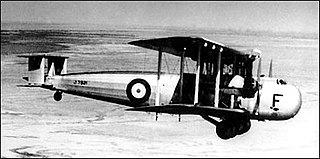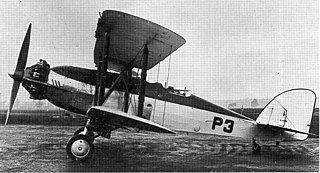
The Bristol Pegasus is a British nine-cylinder, single-row, air-cooled radial aero engine. Designed by Roy Fedden of the Bristol Aeroplane Company, it was used to power both civil and military aircraft of the 1930s and 1940s. Developed from the earlier Mercury and Jupiter engines, later variants could produce 1,000 horsepower from its capacity of 1,750 cubic inches by use of a geared supercharger.

The Westland Lysander is a British army co-operation and liaison aircraft produced by Westland Aircraft that was used immediately before and during the Second World War.

The Hawker Hind was a British light bomber of the inter-war years produced by Hawker Aircraft for the Royal Air Force. It was developed from the Hawker Hart day bomber introduced in 1931.

The Saunders Roe A.27 London was a British military biplane flying boat built by the Saunders Roe company. Only 31 were built, entering service with the Royal Air Force (RAF) in 1936. Although due for replacement by the outbreak of World War II, they saw some active service pending the introduction of the ultimately unsuccessful Lerwick.

The Bristol Bombay was a British troop transport aircraft adaptable for use as a medium bomber flown by the Royal Air Force (RAF) during the Second World War.

The Bristol Brigand was a British anti-shipping/ground attack/dive bomber aircraft, developed by the Bristol Aeroplane Company as a replacement for the Beaufighter. A total of 147 were built and were used by the Royal Air Force in Malaya during the Malayan Emergency and Kenya until replaced by the de Havilland Hornet in Malaya and the English Electric Canberra jet bomber elsewhere.

The Sopwith T.1 Cuckoo was a British biplane torpedo bomber used by the Royal Naval Air Service (RNAS), and its successor organization, the Royal Air Force (RAF). The T.1 was the first landplane specifically designed for carrier operations, but it was completed too late for service in the First World War. After the Armistice, the T.1 was named the Cuckoo.

The Hawker Fury is a British biplane fighter aircraft used by the Royal Air Force in the 1930s. It was a fast, agile aircraft, and the first interceptor in RAF service capable of speed higher than 200 mph in level flight. It was the fighter counterpart to the Hawker Hart light bomber.

The Vickers Vildebeest and the similar Vickers Vincent were two very large two- to three-seat single-engined British biplanes designed and built by Vickers and used as light bombers, torpedo bombers and in army cooperation roles. First flown in 1928, it remained in service at the start of the Second World War, with the last Vildebeests flying against Japanese forces over Singapore and Java in 1942.

The Vickers Valentia was a British biplane bomber transport aircraft built by Vickers for the Royal Air Force. The majority built were conversions of the earlier Vickers Victoria, itself derived from the Vickers Virginia.

The Vickers Type 56 Victoria was a British biplane freighter and troop transport aircraft used by the Royal Air Force. The Victoria flew for the first time in 1922 and was selected for production over the Armstrong Whitworth Awana.

The Vickers Vernon was a British biplane troop carrier used by the Royal Air Force. It entered service in 1921 and was the first dedicated troop transport of the RAF.

The Bristol Fairchild Bolingbroke is a maritime patrol aircraft and trainer used by the Royal Canadian Air Force during the Second World War. Produced by Fairchild-Canada, it was a license-built version of the Bristol Blenheim Mk IV bomber.

The Handley Page Hinaidi was one of two twin-engine bombers built by Handley Page that served with the Royal Air Force between 1925 and 1935. The aircraft was developed from the Handley Page Hyderabad and named after Hinaidi, an RAF station in Iraq.

The Gloster Gauntlet was a single-seat biplane fighter designed and produced by the British aeroplane manufacturer Gloster Aircraft in the 1930s. It was the last fighter to be operated by the Royal Air Force (RAF) to have an open cockpit, and also the penultimate biplane fighter in its service.

The Hawker Horsley was a British single-engined biplane bomber of the 1920s. It was the last all-wooden aircraft built by Hawker Aircraft, and served as a medium day bomber and torpedo bomber with Britain's Royal Air Force between 1926 and 1935, as well as the navies of Greece and Denmark.

The Westland Wapiti was a British two-seat general-purpose military single-engined biplane of the 1920s. It was designed and built by Westland Aircraft Works to replace the Airco DH.9A in Royal Air Force service.

The Fairey Hendon was a British monoplane, heavy bomber of the Royal Air Force, designed by Fairey Aviation in the late 1920s. The aircraft served in small numbers with one squadron of the RAF between 1936 and 1939. It was the first all-metal construction low-wing monoplane to enter service with the RAF.

The Handley Page H.P.54 Harrow was a heavy bomber designed and produced by the British aircraft manufacturer Handley Page. It was operated by the Royal Air Force (RAF) and used during the Second World War, although not as a bomber.

The Westland PV-3 was a British two-seat torpedo bomber of the 1930s built by Westland Aircraft Works. The aircraft was a private venture development and based on the Westland Wapiti. It never entered production. The aircraft is best known as one of the first two to fly over Everest as part of the Houston-Mount Everest Flight Expedition.























